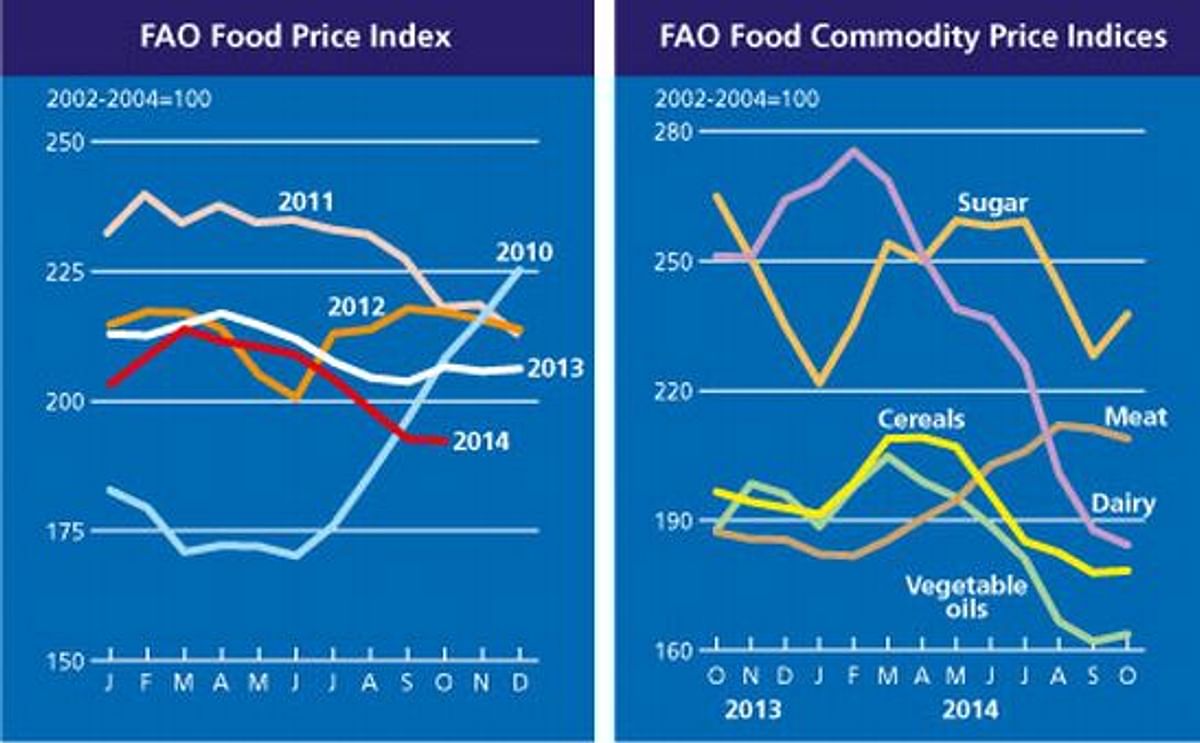The FAO Food Price Index averaged 192.3 points in October 2014, marginally (0.2 percent) below the revised September figure but 14.3 points (6.9 percent) short of its corresponding level one year ago. A firming of international prices of oils and, especially, of sugar, compensated for a retreat of dairy and meat, while cereal prices remained stable around their relatively low September value.
The FAO Cereal Price Index averaged 178.4 points in October, virtually unchanged from September, but 18.2 points (9.3 percent) lower year-on-year. After five months of steep falls, international prices of wheat and coarse grains firmed slightly in October, supported by harvest delays in the United States (maize) and deteriorating prospects in Australia (wheat). On the other hand, rice prices tended to soften on newly harvested supplies and a slowing pace of sales.
The FAO Vegetable Oil Price Index averaged 163.7 points in October, 1.6 points (1.0 percent) up from September, interrupting the declining trend initiated in April 2014. Palm oil strongly contributed to the reversal, as production slowdowns in Malaysia and Indonesia, combined with a revival in global import demand caused palm oil prices to strengthen after six consecutive months of contraction. Sunflower seed quotations also rose, mostly reflecting smaller than anticipated harvests in the Black Sea region. By contrast, soyoil prices weakened further, still driven by the prospect of ample availabilities.
The FAO Dairy Price Index averaged 184.3 points in October, down 3.5 points (1.9 percent) from September and 66.8 points (26.6 percent) less year-on-year. Quotations for butter and whole and skimmed milk powder fell, while those for cheese were unchanged. The October slide constituted the eighth consecutive monthly decline, bringing the Index to its lowest value since August 2012.
The FAO Meat Price Index averaged 208.9 points in October, 2.3 points (1.1 percent) less than its revised value for September. However, quotations for most types of meat are still at historic highs and the Index stands 21.6 points (11.5 percent) above its corresponding level in 2013, principally because of strong bovine meat prices. In October 2014, the quotations of bovine meat and, especially, pig meat moved lower, while those of poultry and ovine meat were, respectively, stable and slightly stronger. Pig meat prices have shown signs of weakness since July, as production recovered in some of the countries affected by outbreaks of porcine epidemic diarrhea (PED) – reducing import demand and increasing availability for export. Also, favourable weather and prices are supporting a recovery in the bovine herd in Australia and hence export availability.
The FAO Sugar Price Index averaged 237.6 points in October, up 9.5 points (4.2 percent) from September 2014. Last month’s rebounding mainly followed reports of a smaller than expected sugarcane crop in drought-affected areas in Brazil. However, against a backdrop of ample supplies, international sugar prices remain more than 10 percent below their level in October 2013.
The FAO Food Price Index stabilizes in October

Like to receive news like this by email? Join and Subscribe!
Join Our Telegram Channel for regular updates!
Sponsored Content
Sponsored Content
Sponsored Content
Sponsored Content
Sponsored Content











